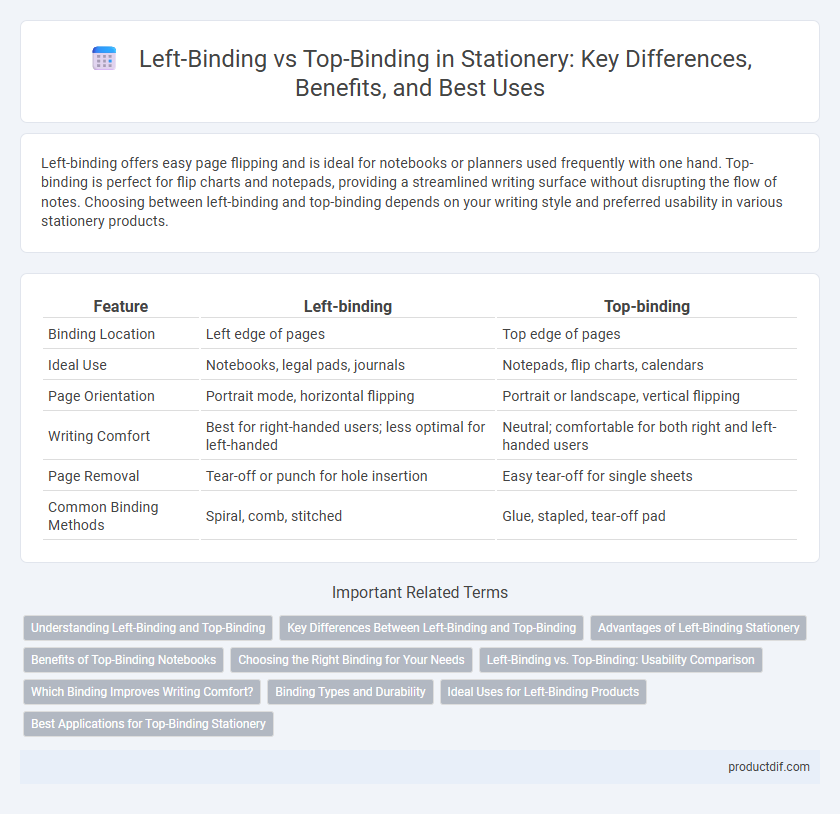Left-binding offers easy page flipping and is ideal for notebooks or planners used frequently with one hand. Top-binding is perfect for flip charts and notepads, providing a streamlined writing surface without disrupting the flow of notes. Choosing between left-binding and top-binding depends on your writing style and preferred usability in various stationery products.
Table of Comparison
| Feature | Left-binding | Top-binding |
|---|---|---|
| Binding Location | Left edge of pages | Top edge of pages |
| Ideal Use | Notebooks, legal pads, journals | Notepads, flip charts, calendars |
| Page Orientation | Portrait mode, horizontal flipping | Portrait or landscape, vertical flipping |
| Writing Comfort | Best for right-handed users; less optimal for left-handed | Neutral; comfortable for both right and left-handed users |
| Page Removal | Tear-off or punch for hole insertion | Easy tear-off for single sheets |
| Common Binding Methods | Spiral, comb, stitched | Glue, stapled, tear-off pad |
Understanding Left-Binding and Top-Binding
Left-binding secures pages along the left edge, ideal for documents read like a book, enhancing ease of flipping through content one page at a time. Top-binding fastens pages along the top edge, commonly used for notebooks or notepads, allowing pages to be flipped vertically and providing a compact writing surface. Choosing between left-binding and top-binding depends on document orientation and user convenience preferences.
Key Differences Between Left-Binding and Top-Binding
Left-binding arranges pages with the binding on the left edge, allowing for easy flipping similar to a book, ideal for documents that read from left to right. Top-binding secures pages along the top edge, making it suitable for notepads or calendars where flipping pages upward is more practical. The choice between left-binding and top-binding depends on usability preferences and the intended reading or writing flow of the stationery.
Advantages of Left-Binding Stationery
Left-binding stationery offers superior ease of use for right-handed individuals, allowing smooth page turning without smudging ink or disrupting writing flow. It supports organized note-taking by enabling a natural left-to-right progression, ideal for documents requiring frequent reference or annotation. This binding style also enhances durability and professional appearance, making it suitable for reports, manuals, and presentations.
Benefits of Top-Binding Notebooks
Top-binding notebooks offer enhanced ease of use by allowing pages to be flipped upward, making them ideal for left-handed users and reducing hand interference while writing. This binding style supports a compact footprint, perfect for note-taking in tight spaces and easy flipping without damaging pages. The top-binding design also enables straightforward page removal, enhancing organization and flexibility in managing notes.
Choosing the Right Binding for Your Needs
Left-binding notebooks offer easy flipping and writing comfort, ideal for tasks requiring frequent note-taking or sketching, while top-binding notebooks provide a streamlined surface for lists and forms, preventing page overlap. Consider the primary use, whether it involves left-to-right writing or quick page-turning, and the preferred orientation to determine the best binding style. Evaluating these factors ensures selecting a stationery binding that enhances productivity and user experience.
Left-Binding vs. Top-Binding: Usability Comparison
Left-binding notebooks offer easier page flipping for right-handed users and provide a stable writing surface, ideal for note-taking and document organization. Top-binding notebooks, often spiral-bound, excel in space-saving and are preferred for tasks requiring frequent page turns without shifting the hand position. Comparing usability, left-binding suits sequential reading and writing, while top-binding benefits quick referencing and compact desk setups.
Which Binding Improves Writing Comfort?
Left-binding stationery supports natural hand movement for right-handed users, reducing smudging and enhancing writing comfort. Top-binding is ideal for left-handed writers, allowing unrestricted hand placement and smoother page turns. Choosing the right binding, based on dominant hand preference, significantly improves the overall writing experience and ergonomics.
Binding Types and Durability
Left-binding offers enhanced durability for frequent use due to robust spine reinforcement, making it ideal for notebooks and planners that require easy page flipping. Top-binding, often seen in notepads and sketchpads, provides convenience for single-hand use but may experience more wear and tear along the binding edge over time. Selecting the appropriate binding type depends on the intended use, balancing durability needs with user comfort and functionality.
Ideal Uses for Left-Binding Products
Left-binding notebooks and planners are ideal for tasks requiring frequent note-taking and easy page flipping, such as meetings, lectures, and journaling. This binding style allows for comfortable writing with the dominant hand and convenient access to previous pages without disrupting ongoing work. Left-binding products support efficient organization and usability, making them suitable for professional, academic, and personal use.
Best Applications for Top-Binding Stationery
Top-binding stationery is best suited for notepads, calendars, and forms requiring easy page flipping and tear-off functionality. This binding method allows for quick access and clean removal of sheets without disturbing the remaining pages, ideal for note-taking and checklist formats. Businesses benefit from top-binding in promotional pads and order forms where efficiency and durability are essential.
Left-binding vs Top-binding Infographic

 productdif.com
productdif.com